Art Lovers discussion
Introduce an Artist and/or Work
>
Jozef Mehoffer--A Polish Symbolist
date newest »
newest »
 newest »
newest »


Strange Garden
1902-1903
National Museum in Warsaw
Strange Garden is one of the most exquisite and mysterious works in the history of Polish painting. It was made during a very significant period in Mehoffer’s life – when already became successful as an artist and was happily married. Mehoffer produced The Strange Garden when he was away on a family holiday. In the painting, he captures familial happiness.

The glowing, golden boy gathers our attention. Withdrawn somewhat into the shade, the woman wearing a sapphire gown looks on close by while a massive sapphire dragonfly hovers over them with its golden latticework wings outstretched in a protective embrace.

You are probably amused by this huge insect. An excerpt from a letter the artist wrote to his wife helps us to interpret its symbolic meaning: “Now, you are to me practically synonymous with the colour of sapphire, and holding you close, though across such a distance, I immerse myself in that colour.” Perhaps, this suggests that the dragonfly keeping watch over the family, which Mehoffer had identified as a symbol for the sun, is actually the artist himself.
Several years before painting the picture, Mehoffer had written in his journal: “I can’t say that I know what to paint, the idea is a general one: an idea of life, delight, pleasure, joy, light, sunshine and warmth.”
 As part of this undertaking, (The Strange Garden), Polish art had already caught the attention of the public in 2000; when the work of the painter Jacek Malczewski (1854-1929), Mehoffer's elder by a few years, was shown. Both stand among the most remarkable personalities of the avant-garde that developed at the turn of the century calling itself "Young Poland", an appellation that signified their willingness to break from the heritage of the past from a pictorial point of view.
As part of this undertaking, (The Strange Garden), Polish art had already caught the attention of the public in 2000; when the work of the painter Jacek Malczewski (1854-1929), Mehoffer's elder by a few years, was shown. Both stand among the most remarkable personalities of the avant-garde that developed at the turn of the century calling itself "Young Poland", an appellation that signified their willingness to break from the heritage of the past from a pictorial point of view.To this end, Mehoffer, disregarding the advice of his teacher Jan Matejko (1838-1893), director of the School of Fine Arts in Krakow, and a painter famous for his evocations of tragic and glorious episodes of Polish history, went to Paris in 1891. He remained in France until 1895 – this sojourn is represented in the exhibition by two pieces dated 1894 from the Poznán National Museum, Place Pigalle in Paris and Self-Portrait. This trip was preceded by a year of study in Vienna. In his lifetime, the reputation of the artist reached far beyond the borders of his country. He was awarded a gold medal for his outstanding participation to the Paris World Fair in 1900 and the Saint Louis World Fair in 1904. He was also a member of the Viennese Secession.
Despite this international celebrity, one should not overlook his militant action for the recognition of a national art. In 1897, Mehoffer was among the founders of the society Sztuka, which proclaimed the independence of Polish art and refused from then on to have their work exhibited abroad as part of Russian, Austrian or German sections.

Angel

Angels with stars
It was in the field of monumental art that the artist's commitment found its most remarkable expression, as testify the impressive sketches (Krakow, National Museum and Poznán, National Museum) for the frescoes designed between 1901 and 1903 for such national monuments as the cathedrals in Wawel and Plock.
https://www.musee-orsay.fr/en/events/...
 His activity as a decorator was dominated by an exceptional undertaking that was to stretch for nearly forty years: the execution, following an international competition won in 1895, of glass panels for thirteen windows of the Friburg cathedral (Switzerland). Their composition, rich and teeming, in which human figures mingle in an artificial intensely and luminously coloured decorative nature, follows Symbolism and Art Nouveau while paying homage to national traditions.
His activity as a decorator was dominated by an exceptional undertaking that was to stretch for nearly forty years: the execution, following an international competition won in 1895, of glass panels for thirteen windows of the Friburg cathedral (Switzerland). Their composition, rich and teeming, in which human figures mingle in an artificial intensely and luminously coloured decorative nature, follows Symbolism and Art Nouveau while paying homage to national traditions.
Caritas
Musée National de Cracovie
The same applies to easel paintings, not only in the themes - The Muse, 1904 (Krakow, National Museum) and Medusa, 1904 (Krakow, Jagellons University Museum)-, but also by a refusal of naturalism and the illusion of depth in favour of lines and colours.

Medusa
 This aspect is particularly striking in the admirable series of portraits the artist made of his wife, whether one considers full-length portraits or busts. Jawidga Mehoffer's elegant, sometimes hieratic silhouette, and the serene beauty of her face stand out, in a manner similar to that adopted by the artists of the Viennese Secession, against richly ornate backgrounds merging with the rich clothes in which the model's dresses are cut. Jadwiga appears yet again, wrapped in a changing and rustling piece of silk, contrasting with the blond nudity of her son, who, on a warm summer's day, indulges in the luxurious atmosphere tainted with surrealism of The Strange Garden, the enigmatic character of with is still unexplained.
This aspect is particularly striking in the admirable series of portraits the artist made of his wife, whether one considers full-length portraits or busts. Jawidga Mehoffer's elegant, sometimes hieratic silhouette, and the serene beauty of her face stand out, in a manner similar to that adopted by the artists of the Viennese Secession, against richly ornate backgrounds merging with the rich clothes in which the model's dresses are cut. Jadwiga appears yet again, wrapped in a changing and rustling piece of silk, contrasting with the blond nudity of her son, who, on a warm summer's day, indulges in the luxurious atmosphere tainted with surrealism of The Strange Garden, the enigmatic character of with is still unexplained.
Portrait of the Artist's Wife on a Yellow Background
Musée National de Varsovie
https://www.musee-orsay.fr/en/events/...


Cathédrale St-Nicolas de Fribourg (Suisse)
Vitrail des saints Georges, Michel, Anne et Marie-Madeleine


Cathédrale St-Nicolas de Fribourg (Suisse)
Armoiries du chapitre collégial de St-Nicolas sur le vitrail de l'Eglise
 Jozef Mehoffer was born in 1869. Though Polish, his family was of Austrian ancestry. He studied, first in Krakow, later in Vienna and Paris developing an expertise in portraits, graphic art, stained glass, textiles, chalk drawings, etchings, and book illustrations. He even designed theater sets and furniture. With all these skills, Mehoffer first gained acclaim around 1895, when he was commissioned to design the stained glass windows for the Gothic St. Nicholas Collegiate Church in Fribourg, Switzerland. It was a project that was to occupy him sporadically for the next forty years. Mehoffer's work was so popular that for much of his career he did little but stained glass. Painting became something of a sideline, whenever he could find the time.
Jozef Mehoffer was born in 1869. Though Polish, his family was of Austrian ancestry. He studied, first in Krakow, later in Vienna and Paris developing an expertise in portraits, graphic art, stained glass, textiles, chalk drawings, etchings, and book illustrations. He even designed theater sets and furniture. With all these skills, Mehoffer first gained acclaim around 1895, when he was commissioned to design the stained glass windows for the Gothic St. Nicholas Collegiate Church in Fribourg, Switzerland. It was a project that was to occupy him sporadically for the next forty years. Mehoffer's work was so popular that for much of his career he did little but stained glass. Painting became something of a sideline, whenever he could find the time.
stained glass windows for the Gothic St. Nicholas Collegiate Church
Fribourg, Switzerland
 Later in his career, as he grew comfortable financially, Mehoffer became interested in the Medieval style of painting, as he produced a lengthy series of works depicting Christ's journey from the court of Pilate (above) to his Descent from the Cross (below). In later years, Mehoffer's paintings also encompassed various scenes of Krakow and his home life. He was in the enviable position of being able to paint for himself, rather than at the behest of others.
Later in his career, as he grew comfortable financially, Mehoffer became interested in the Medieval style of painting, as he produced a lengthy series of works depicting Christ's journey from the court of Pilate (above) to his Descent from the Cross (below). In later years, Mehoffer's paintings also encompassed various scenes of Krakow and his home life. He was in the enviable position of being able to paint for himself, rather than at the behest of others.
Descent from the Cross
1933

The Market of Krakow
1903
http://art-now-and-then.blogspot.com/...
 Between Symbolism and Post-Impressionism
Between Symbolism and Post-ImpressionismBoth Mehoffer's easel and monumental painting was an excellent manifestation of the rich symbolism and decorative trends in Polish modernism and of the artist's masterly technique. His art was strongly influenced by the monumental painting of Puvis de Chavannes, which he saw in Paris, and the Nabist art, which he came to know through Władysław Ślewiński. His art of 1891-5 was influenced by Symbolism and Post-Impressionism. Intense expression, typical of the moods of Young Poland, can be found in the landscapes Wisła pod Niepołomicami (The Vistula near Niepołomice) (1894) and Zachód słońca. Park Jordana - Zapisy Zmierzchu (Sunset. The Jordan Park – the Impression of the Dusk), showing the sunset glow. The thick impasto and the brisk, free brush strokes reveal a kinship with the art of Jan Stanisławski.
Mehoffer's mature art (from 1895-1914) made an original contribution to the development of Symbolist iconography. His paintings, some evoking a lyrical, decadent mood (Wąwóz. La Gorge de L'Areuse, 1897), others brimming with admiration for the sensuous beauty of nature, proved a perfect embodiment of modernist poetics.
The rich, resounding, saturated colours used in exquisite combinations, the confident, lithe edges, the perfect outline of forms, the masterly harmony of decorative flatness and of profusion of ornaments, combined with modelling which emphasizes the forms are characteristic of Mehoffer's allegoric and symbolic works - Muza (The Muse), 1897; Europa Jubilans, 1905) and portraits - Portret Izy z Gielgudow Axentowiczowej (Portrait of Iza Axentowicz nee Gielgud, 1907). The artist was just as proficient in evoking the intimate mood of bourgeois interiors Rozmowa (Conversation, 1896) with their nooks and crannies filled with ornamental objects and reflected in the panes of mirrors - Drobiazgi na kominku (Some Objects andthe Fireplace, 1895).
 After 1914 Mehoffer lightened up his palette, added a post-Impressionistic glimmer to colour and gave supremacy to colour spots over the outline. The elaborate metaphor of his early works gave way to a direct approach to nature and a spontaneous affirmation of its beauty, with landscapes taking a privileged position in his art. Mehoffer's paintings from the late 1920s reveal brisk brushstrokes and soft modelling of form. In his late work his Impressionistic, open-air sensitivity to shifting light and colour is reinforced into decorative combinations of colour spots, sunny reflections change into golden spots gliding across the grass and tree trunks, faces of models glow with tones of pink muted, where shadowed, with hues of green and blue. The motionless, pensive figures, juxtaposed with an isolated section of nature or an ornamental background, are reminiscent of his earlier, Symbolist paintings.
After 1914 Mehoffer lightened up his palette, added a post-Impressionistic glimmer to colour and gave supremacy to colour spots over the outline. The elaborate metaphor of his early works gave way to a direct approach to nature and a spontaneous affirmation of its beauty, with landscapes taking a privileged position in his art. Mehoffer's paintings from the late 1920s reveal brisk brushstrokes and soft modelling of form. In his late work his Impressionistic, open-air sensitivity to shifting light and colour is reinforced into decorative combinations of colour spots, sunny reflections change into golden spots gliding across the grass and tree trunks, faces of models glow with tones of pink muted, where shadowed, with hues of green and blue. The motionless, pensive figures, juxtaposed with an isolated section of nature or an ornamental background, are reminiscent of his earlier, Symbolist paintings.https://culture.pl/en/artist/jozef-me...
 His portraits, in turn, reveal mastery in veristic rendering of physiognomic features of the models, lending them both an intimate feel... and a formal touch
His portraits, in turn, reveal mastery in veristic rendering of physiognomic features of the models, lending them both an intimate feel... and a formal touch
The Rose of Saron (Portrait of Zofia Minder)
 Portraits of his Wife
Portraits of his WifeMehoffer's fascination with the decorativeness of elegant dress, the shape of stylish hats, the noble, patterned fabrics and the intricate design of stained glass is at its best when he paints his wife, Jadwiga née Janakowska. He depicts her against an ornamental backdrop or inside interiors filled with precious things

At the Summer House
1904
 Wearing a sapphire dress, she is also present in Dziwny Ogród (The Strange Garden 1902-1903)- the monumental painting of most mysterious symbolism, impressing with its powerful colours and finesse of line, loaded with positive emotions, harmoniously uniting human with natural order, and revealing a fragment of Eden which is presented as tantamount to familial bliss. The artist's young son, bright and luminous in the foreground, attracts one's attention as strongly as does the exaggerated dragonfly with golden wings, flying against the dense crowns of fruit-bearing apple trees. The surreal and at the same time solemn atmosphere of a sunlit orchard is intensified by the garlands of flowers wrapped around the tree trunks and symbolic of nature's abundance.
Wearing a sapphire dress, she is also present in Dziwny Ogród (The Strange Garden 1902-1903)- the monumental painting of most mysterious symbolism, impressing with its powerful colours and finesse of line, loaded with positive emotions, harmoniously uniting human with natural order, and revealing a fragment of Eden which is presented as tantamount to familial bliss. The artist's young son, bright and luminous in the foreground, attracts one's attention as strongly as does the exaggerated dragonfly with golden wings, flying against the dense crowns of fruit-bearing apple trees. The surreal and at the same time solemn atmosphere of a sunlit orchard is intensified by the garlands of flowers wrapped around the tree trunks and symbolic of nature's abundance. 
A Strange Garden
1902-1903
https://culture.pl/en/artist/jozef-me...

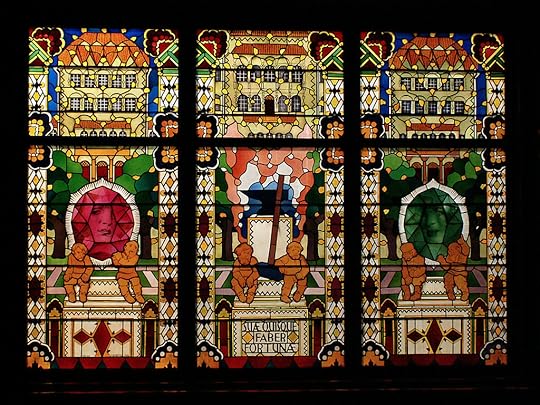
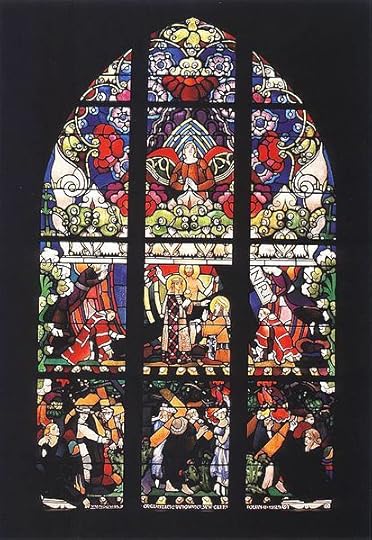
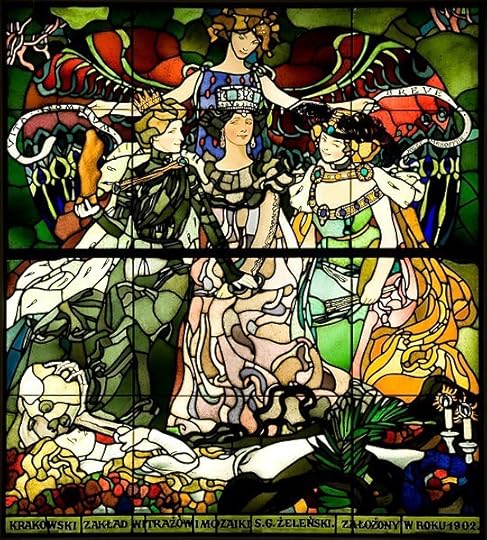
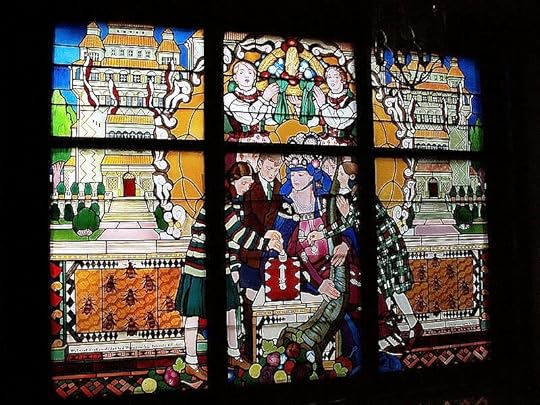
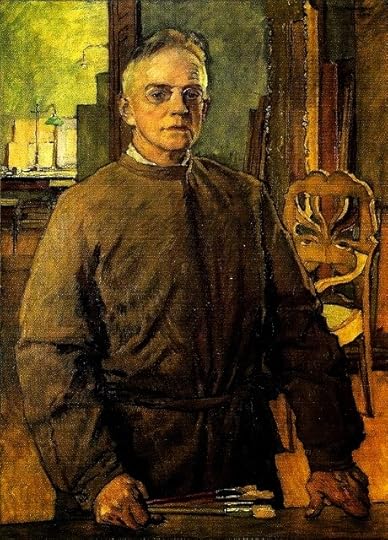
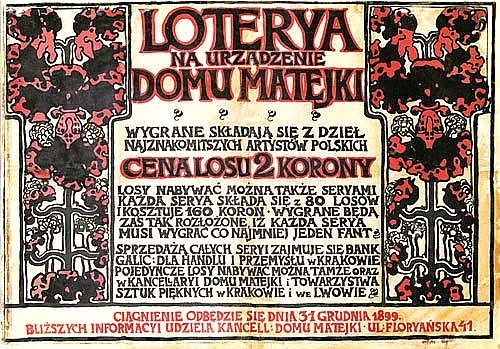
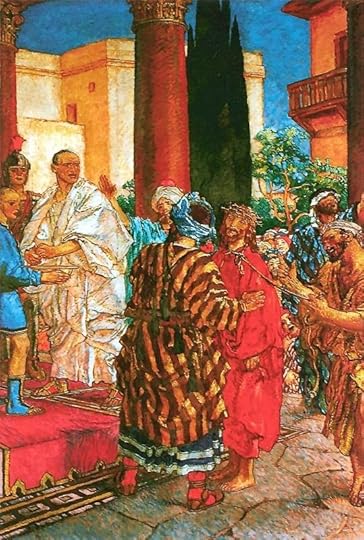
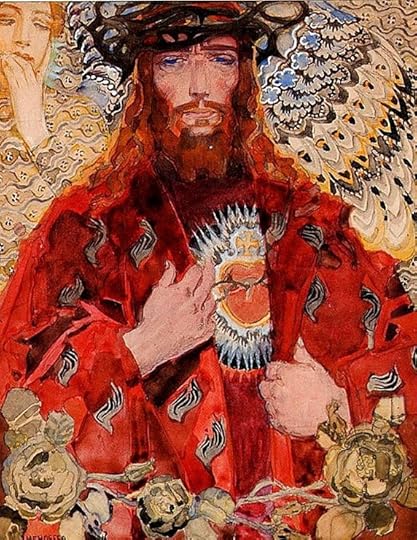


Self Portrait
1869
National Museum in Krakow
Mehoffer was a painter, graphic artist, printmaker, designer of stained glass, textiles, theatre sets, posters, interior decoration and furniture, leading representative of Young Poland. His international acclaim came with designs of stained glass windows for the Gothic St Nicholas collegiate church in Freiburg, Switzerland but he was most well known in Poland. His monumental painting was an excellent manifestation of the rich symbolism and decorative trends in Polish modernism and of the artist’s masterly technique. His art was strongly influenced by the monumental painting of Puvis de Chavannes, which he saw in Paris, and the Nabist art, which he came to know through Władysław Ślewiński. His art of 1891-5 was influenced by Symbolism and Post-Impressionism.
http://www.dailyartmagazine.com/jozef...